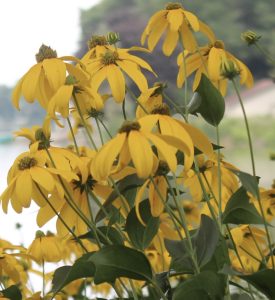Authored by: Carolyn Aita/Master Gardener Volunteer Intern
Who can resist blossoms that are the yellow-orange hues of the rising sun? Not many of us, which accounts for the popularity of rudbeckias in gardens of all sizes and all attitudes from formal to free-wheeling. Rudbeckias grew in our climate before Europeans settled in Wisconsin. These native species and their varieties and cultivars light up our gardens today from spring until the first frost.
Rudbeckia flowers have petals, or rays, surrounding a central cone, or eye. The eye is laden with pollen and nectar. This arrangement, called an open composite flower, is preferred by many floral visitors, including butterflies, moths, bees, wasps, and flies, because nourishment is so easily accessible. Native rudbeckias are essential elements of pollinator gardens.
Five native rudbeckias that work well as Wisconsin landscape plants are black-eyed susan, brown-eyed susan, orange coneflower, sweet black-eyed susan, and wild golden glow. Black-eyed susan and brown-eyed susan, are short-lived but they seed prolifically. Once planted in your garden, consider them exuberant permanent residents. Most of us are familiar with black-eyed susan, Rudbeckia hirta, also called gloriosa daisy. It is everywhere in our national wild landscape. As a child I delighted in seeing black-eyed susan’s large bright flowers held upright on single one to three foot long stems in farm hedge rows and along woodland edges. Brown-eyed susan, Rudbeckia triloba, is a bushy plant, two to five feet tall, bearing many small flowers. Both black-eyed susan and brown-eyed susan have brown eyes. These two quick-to-establish plants grow in full or partial sun in many soil and moisture conditions and have long bloom seasons throughout summer and fall. Fuzzy stems and leaves make them unappealing to grazing rabbits and deer.
Orange coneflower, black-eyed susan, and wild golden glow are long-lived clumping perennial plants. Bright orange flowers with brown velvet eyes unabashedly atop two to four foot branched stems from June to September is the hallmark of orange coneflower, Rudbeckia fulgida. A cultivated variety of orange coneflower that is enormously popular with weekend gardeners and professional landscapers alike is ‘Goldsturm’ (Rudbeckia fulgida var. sullivantii ‘Goldsturm,’). Native orange coneflower is slightly taller and more openly branched than ‘Goldsturm’ giving it a less compact appearance. Possibly, this slight structural change makes native orange coneflower less susceptible to fungal leaf spot diseases than Goldsturm, and it is well worth considering it rather than the popular cultivar.
Sweet black-eyed susan, Rudbeckia subtomentosa, is a bushy four to six foot tall plant that begins to bloom in the heat of August and continues until frost. Its longevity and its ability to withstand both heat and cold make sweet black-eyed susan a valuable plant for prairie restorations as well as for permanent plantings in difficult spots in smaller gardens. Both orange coneflower and sweet black-eyed susan love full sun but also do well in partial sun.
Wild golden glow, Rudbeckia laciniata, also called green-headed coneflower and cutleaf coneflower, is a majestic plant with lush dark green leaves and large bright yellow green-eyed flowers atop five to eight feet branched stems. Its tolerance of moist soil and shade account for its design ultility. Repetition of stands of wild golden glow add architectural elements to a large garden. A small garden will find drama in a single wild golden glow specimen plant.
Carolyn Aita
Master Gardener Volunteer Intern





